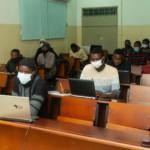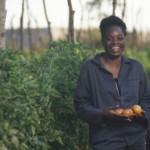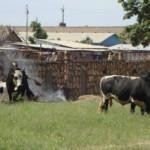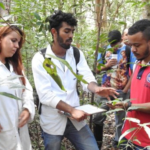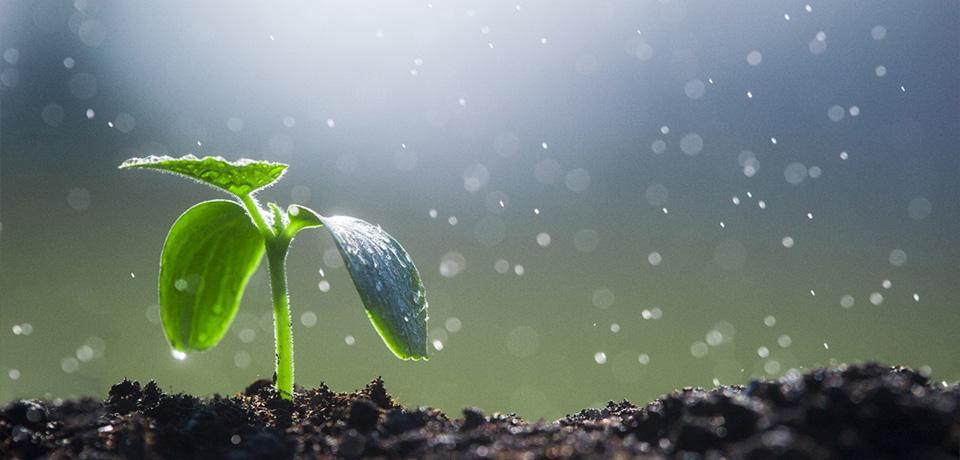
Kamuti Mulonda, Annah Indeche, Lydia Mumbi Chabala, Peter Kaluba, Paul Simfukwe, Siatwiinda M. Siatwiinda, Charles Orek, Joyce J. Lelei, Vincent Canwat, Elijah Phiri, Satu Määttänen & Eija Laitinen
To solve the pressing concerns of climate change, land degradation, and food insecurity in Sub-Saharan Africa (SSA), a thorough understanding about the complex interactions between soils and the climate system is required. Problem-based learning (PBL) approach can enhance students’ trans-disciplinary understanding and application skills on soils and climate, enabling them to become future problem solvers.
In this article, we discuss how to apply PBL in higher education in soil and climate change sciences in the context of SSA. First, we discuss the status quo of higher education in SSA and the need for a paradigm shift towards PBL. Secondly, we present the step-by-step implementation of PBL and our expectations on the benefits and hindrances of this approach.
Conventional teaching methodology in Sub-Saharan Africa
Soil science and climate change in SSA are traditionally taught in lecture format. The teacher imparts knowledge and learning materials and students passively capture and memorize concepts (Zaidi et al., 2017). Written tests or quizzes, that reward memory, and repetition rather than actual learning are used to assess learning, (Area Moreira, 2008). Traditional soil science teaching includes also a practical field or laboratory component. This, however, is often performed as a routine of prescribed steps and does not necessarily invoke critical thinking or other attributes of active learning (Amador, 2019).
Economic reasons have compelled most universities in SSA to use the lecture-based teaching approach, which requires minor investments in infrastructure and teaching staff (Amador, 2019). In Kenya, for example, public universities rely largely on government subsidies, yet the government capitation covers only around half of the learners (Nganga, 2021). Government funding for Kenyan public universities further decreased in the financial year 2021–2022 (Nganga, 2021). The finances obtained are used mainly for paying salaries with little or no funding available for promoting quality.
The need for institutional shift to PBL in soil and climate change studies
Traditional lecture-based approaches are ineffective in developing competencies that are valued by employers of soil science graduates (Amador, 2019). This emphasizes the need for an educational paradigm shift. The PBL approach is associated with the development of work-life-relevant competencies, such as knowledge integration and application skills (Camp, 1996).
In PBL, learning is initiated by solving complex, real-life problem(s). Soil and climate change studies offer a wide range of problems for students to work with. An in-depth understanding about various soil-climate interactions and knowledge application skills are required to solve these problems. To obtain these, in turn, multifaceted learning approaches that tie theory into practice are required. The interdisciplinary nature of soil and climate change studies may be challenging for students, as it requires understanding and knowledge of many fields, such as chemistry, physics, and biology. However, PBL can promote interdisciplinarity, as students need to think and analyze the problem and possible solutions by cutting and lending across disciplines (Delisle, 1997, p. 10).
PBL application in soil and climate change studies
We use the Sustainable Agriculture-course taught to fourth year agriculture/horticulture bachelor students at Jomo Kenyatta University of Agriculture and Technology, Kenya to illustrate how PBL can be applied in soil and climate change studies.
The following steps, adapted from the approach by Camp et al. (2014), can be used to implement PBL:
1. Problem selection.
The university extension division and teacher identify the partnering farmer(s). A teacher and a farmer formulate the problem and then share it with the students. In this course, students are asked to develop a strategy for converting a conventional farm to conservation agriculture (CA).
2. Brainstorming.
All unfamiliar terms are explained. Guided by the teacher, students source information and discuss options for solving the problem, i.e., how to convert a conventional farm to CA. At this stage all ideas are welcome.
3. Analysis of solutions.
Students, guided by the teacher and consulting the farmer, craft different strategies for converting to CA. Students apply skills and knowledge learned. The focus is on how to avoid possible drawbacks, related e.g., to productivity, during and after the conversion.
4. Practical activities.
Students compare farm areas under CA and conventional farming and perform cost-benefit analyses. Students build a roadmap, including time and resource requirements, for converting a conventional farm to CA. The role of the teacher is to encourage creativity, critical thinking, innovation, and the development of technical and collaborative skills.
5. Reporting.
Students report all activities orally to the teacher, other students, and farmer on the farm-site and prepare a written report. Students are guided to reflect on what they have learned during the process and how this can enhance their careers.
6. Assessment.
Student groups are evaluated using rubrics including problem communication, background, research methods, solutions, resources, and participation. Students fill out learning reflections periodically during and at the end of the process. The farmer may also give students a score based on the farmer-student interaction.
Expected benefits of and potential hindrances on PBL application in soil and climate change studies
We expect PBL to provide students with the competencies required in the 21st-century workplace. According to literature, PBL improves in-depth content knowledge, critical thinking, and problem-solving skills (Kwan & So, 2008), as well as research, communication and collaboration skills (Hmelo-Silver, 2004; Sekhon et al., 2021; Yeung, 2010; Yew & Goh, 2016). Compared with lecture-based teaching, PBL can improve the retention of concepts and skills in the long term (Strobel & van Barneveld, 2009) and increase students’ motivation and confidence (Visser et al., 2002). In PBL, students are exposed to different, even conflicting, views which promote open-mindedness (Yeung, 2010). These are core skills and attitudes required by soil and climate experts.
On a broader societal view, students working with real-life problems can provide usable data and solutions for pressing ecological or socio-economic needs (Pawson et al., 2006). Furthermore, PBL can encourage graduates to view the current challenges as opportunities for entrepreneurship and employment creation.
However, the adoption of new teaching approaches is not a simple task. Implementing PBL requires more organizational skills and resources as compared with lecture-based teaching. Field visits and other off-campus activities require monetary and logistic resources, which may be limited in many universities. Large student numbers, especially in the introductory courses, further increase the costs of fieldwork and may complicate the coordination of PBL and related tasks. Acquiring and involving external stakeholders requires additional planning and thus additional time resources from the teacher. Lastly, motivating students to take responsibility for learning and handling problems independently may take time, especially if PBL approach is new to the students and to the teacher.
Conclusions
Higher education in SSA relies on a lecture-based approach, which may lead to surface learning. Adjusting higher education curricula to include PBL approach can improve students’ learning outcomes, especially within highly complex topics, such as soil and climate studies. This article provided a step-by-step example of how to apply PBL in soil and climate change course. PBL promotes the development of students’ cognitive and affective domains and can help students to become confident and capable of identifying and solving problems in everyday life. Providing students with the core 21st-century skills with PBL can create opportunities in SSA, when graduates utilize acquired skills for entrepreneurship, job creation, and solving pressing challenges.
This article has been written as part of a professional Problem-Based Learning Training Programme for East and Southern African university teachers. The training programme was organized as part of AgriSCALE project (https://www.agriscale.net/) activities during 2021. AgriSCALE is an EU-funded project coordinated by Häme University of Applied Sciences (FIN), that aims to reform agricultural education and curricula in East and Southern African universities. Project partners include nine universities from East and Southern Africa and Europe.
Authors
Kamuti Mulonda, MSc (Water Resources Engineering), Lecturer University of Zambia, Department of Agricultural Engineering.
Annah Indeche, PhD. Lecturer at Jomo Kenyatta University of Agriculture and Technology, Department of Horticulture and Food security.
Lydia Mumbi Chabala, PhD in Soil Science, MSc Agricultural Engineering, BSc Agricultural Sciences. Senior Lecturer in the School of Agricultural Sciences, University of Zambia.
Peter Kaluba, MSc of Physical Land Resources, BSc Agricultural Sciences, Lecturer in the School of Agricultural Sciences, University of Zambia.
Paul Simfukwe, PhD in Environmental Soil Science MSc in Land Degradation, Conservation and Rehabilitation, Lecturer in the School of Agriculture and Natural Resources at Mulungushi University.
Siatwiinda M. Siatwiinda, MSc Climate Studies, lecturer in the School of Agriculture and Natural Resources at Mulungushi University.
Charles Orek, Dr. Sci. Lecturer Plant Pathology & Biotechnology, Department of Agricultural Sciences, South Eastern Kenya University
Joyce J. Lelei, PhD in nat. techn. Lecturer at Egerton University. Research interests in agroecology and sustainable natural resource management.
Vincent Canwat, PhD Fellow Food Business & Development, MA Devt Studies, MSc. Resource & Devt Economics, Lecturer at Gulu University, Uganda.
Elijah Phiri, PhD in Biological Systems, Senior Lecturer in the School of Agricultural Sciences, University of Zambia.
Satu Määttänen, M.Sc. in Arg. & For. and M.Sc. in Biol & Env. Sci. Research Assistant at Häme University of Applied Sciences in the Bio Research Unit.
Eija Laitinen, PhD in Adult Education, Principal Research Scientist in the HAMK Bio Research Unit AgriSCALE and PBL-BioAfrica Project Coordinator and leader of the HAMK Africa
References
Amador, J. A. (2019). Active Learning Approaches to Teaching Soil Science at the College Level. Frontiers in Environmental Science, 7. https://doi.org/doi:10.3389/fenvs.2019.00111
Area Moreira, M. (2008). La innovación pedagógica con TIC y el desarrollo de las competencias informacionales y digitales. Revista de Investigación En La Escuela, 64, 5–17. https://doi.org/https://doi.org/10.12795/IE.2008.i64.01
Camp, G., van het Kaar, A., van der Molen, H. & Schmidt, H. (2014). PBL: step by step – a guide for students and tutors. Institute of Psychology, Erasmus University Rotterdam. https://www.eur.nl/sites/corporate/files/PBL_step_by_step_guide_0.pdf
Camp, G. (1996). Problem-Based Learning: A Paradigm Shift or a Passing Fad? Medical Education Online, 1(1). https://doi.org/10.3402/MEO.V1I.4282
Delisle, R. (1997). How to use problem-based learning in the classroom. Association for Supervision & Curriculum Development, ProQuest Ebook Central.
Hmelo-Silver, C. E. (2004). Problem-Based Learning: What and How Do Students Learn? Educational Psychology Review, 16(3), 235–266. https://doi.org/10.1023/B:EDPR.0000034022.16470.f3
Kwan, T. & So, M. (2008). Environmental learning using a problem-based approach in the field: A case study of a Hong Kong school. International Research in Geographical and Environmental Education, 17(2), 93–113. https://doi.org/10.1080/10382040802148562
Nganga, G. (2021). Gloomy financial outlook after government slashes budgettle. University World News: Africa Edition. https://www.universityworldnews.com/post.php?story.
Pawson, E., Fournier, E., Haigh, M., Muniz, O., Trafford, J. & Vajoczki, S. (2006). Problem-based Learning in Geography: Towards a Critical Assessment of its Purposes, Benefits and Risks. Journal of Geography in Higher Education, 30(1), 103–116. https://doi.org/10.1080/03098260500499709
Sekhon, N., Beach, T., Krause, S. & Eshleman, S. (2021). Understanding climate trends in Central America through practical problem-based learning. Journal of Geography in Higher Education, 45(2), 298–318. https://doi.org/10.1080/03098265.2020.1833318
Strobel, J. & van Barneveld, A. (2009). When is PBL More Effective? A Meta-synthesis of Meta-analyses Comparing PBL to Conventional Classrooms. Interdisciplinary Journal of Problem-Based Learning, 3(1). https://doi.org/10.7771/1541-5015.1046
Visser, L., Plomp, T., Amirault, R. J. & Kuiper, W. (2002). Motivating students at a distance: The case of an international audience. Educational Technology Research and Development, 50(2), 94–110. https://doi.org/10.1007/BF02504998
Yeung, S. (2010). Problem-Based Learning for Promoting Student Learning in High School Geography. Journal of Geography, 109(5), 190–200. https://doi.org/10.1080/00221341.2010.501112
Yew, E. H. J. & Goh, K. (2016). Problem-Based Learning: An Overview of its Process and Impact on Learning. Health Professions Education, 2(2), 75–79. https://doi.org/10.1016/J.HPE.2016.01.004
Zaidi, U., Hammad, L., Awad, S., Qasem, H. & Al-Mahdi, N. A. (2017). Problem-based Learning Vs. Traditional Teaching Methods: Self-efficacy and Academic Performance Among Students of Health and Rehabiliation Sciences College, PNU. Science International Lahore, 29(3), 547–551.

